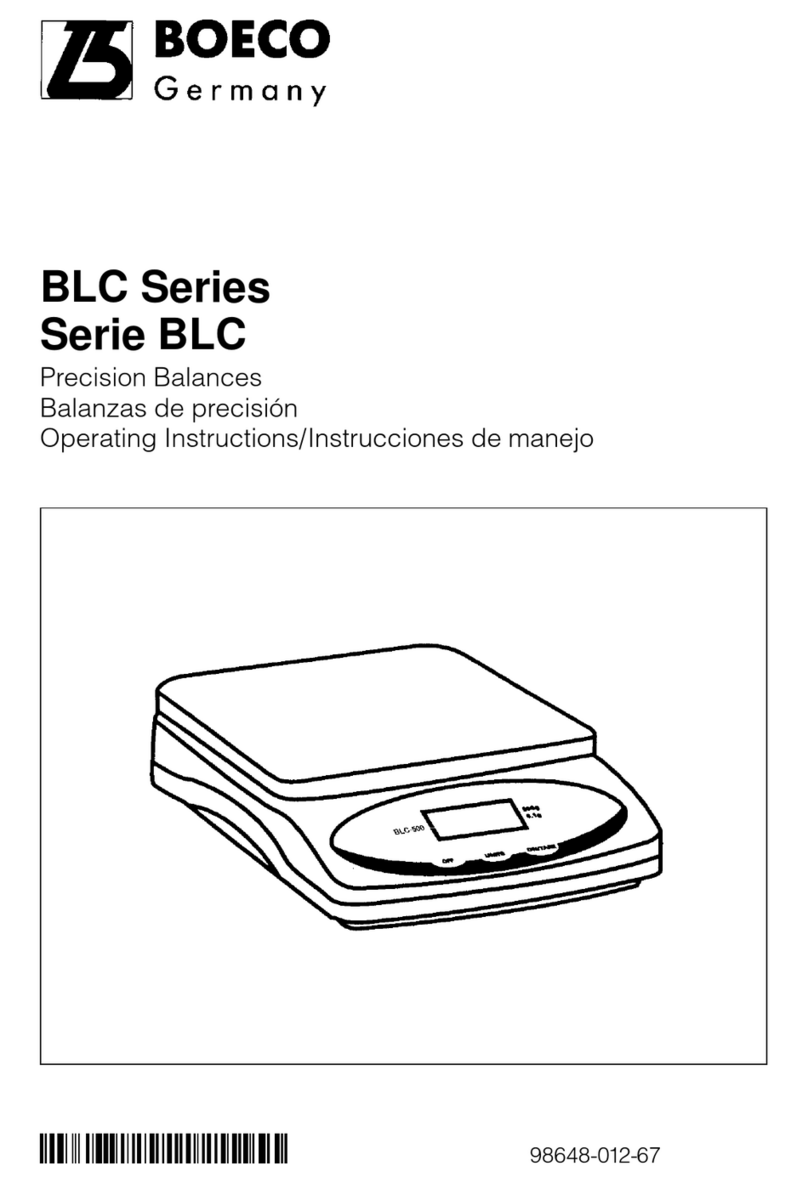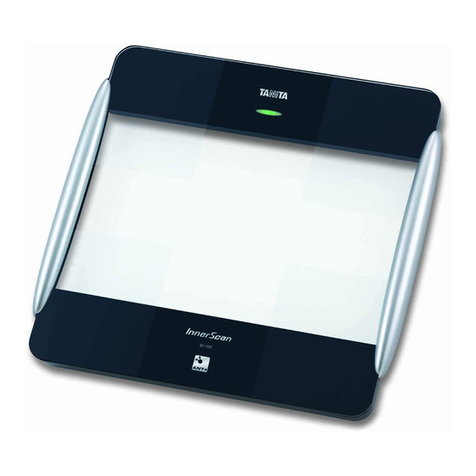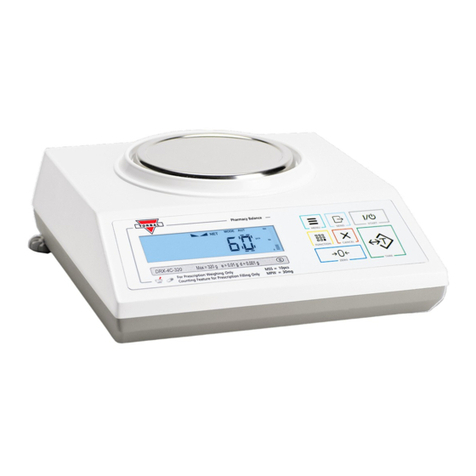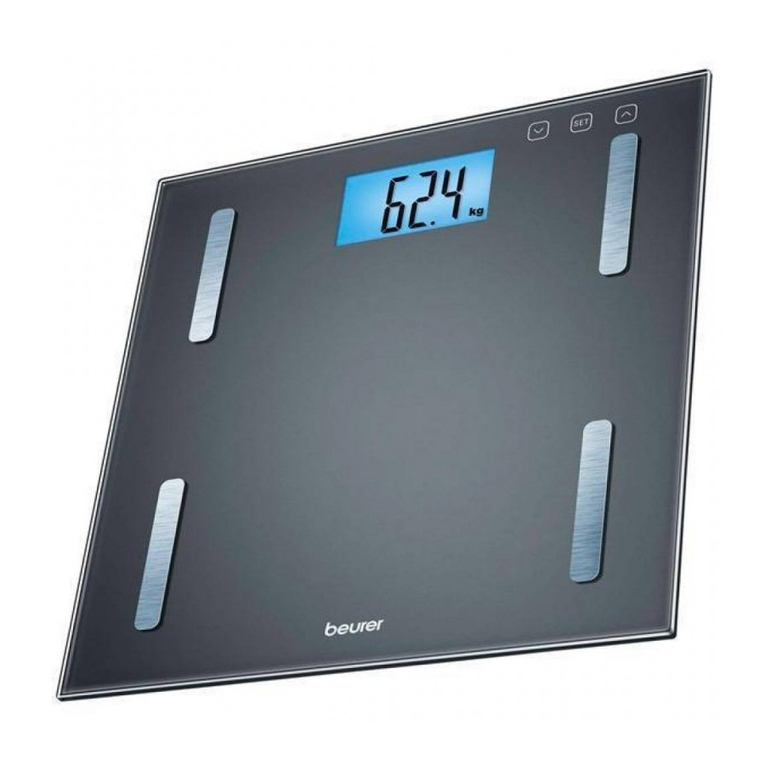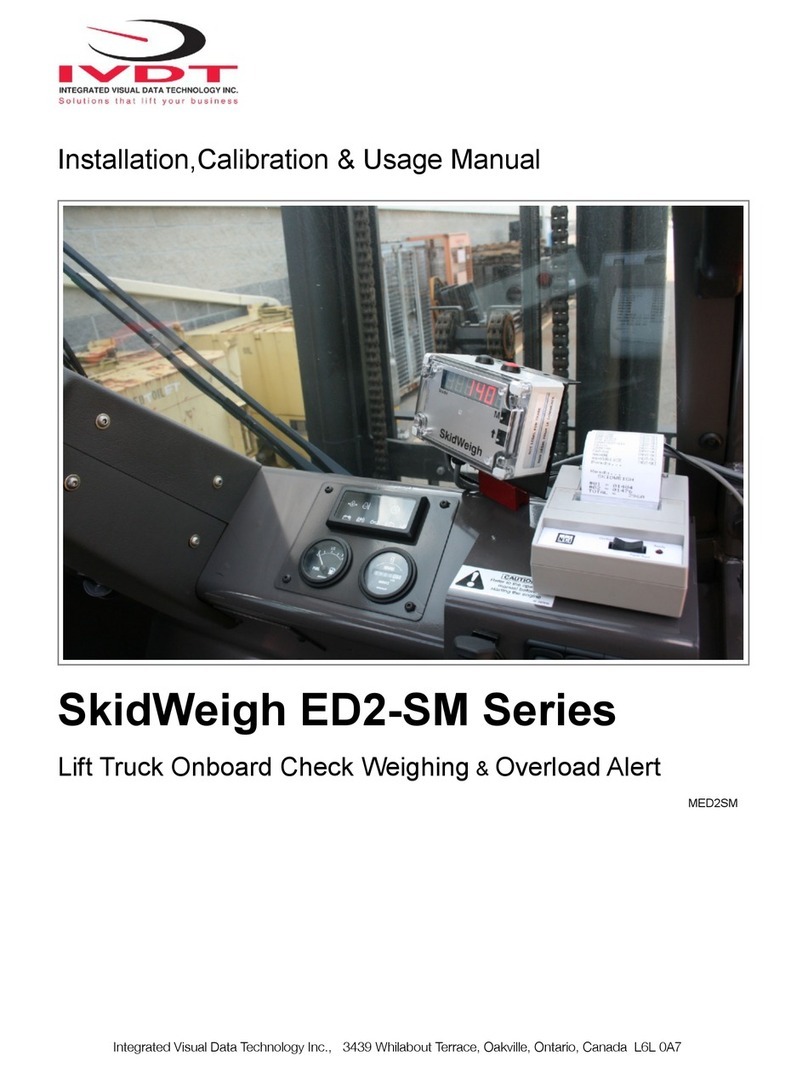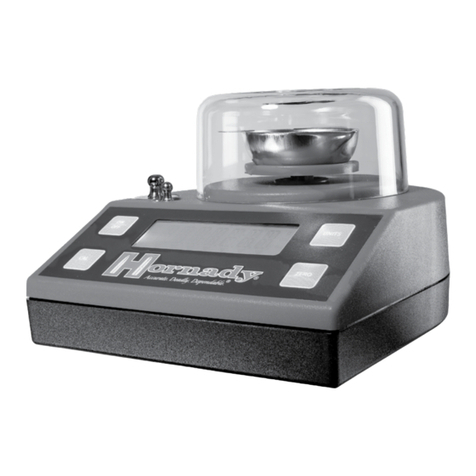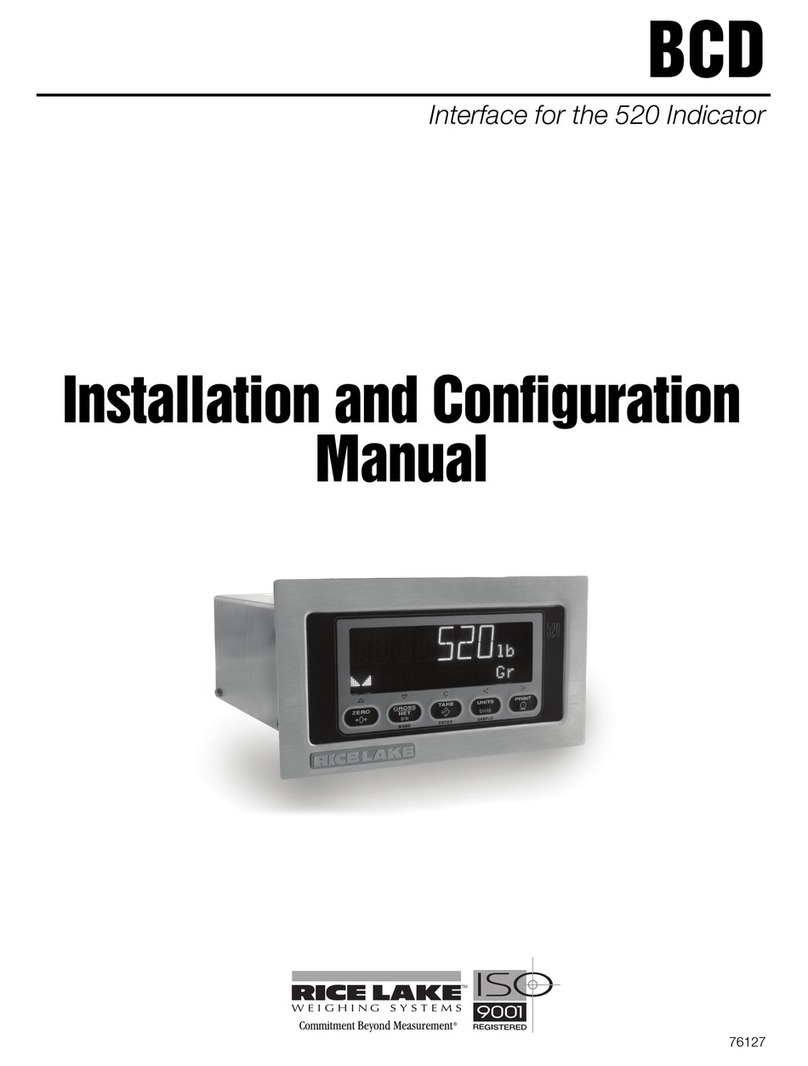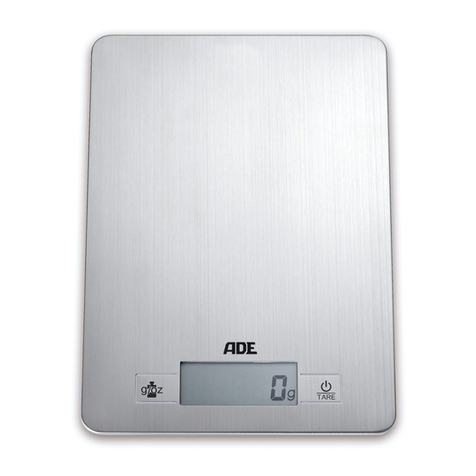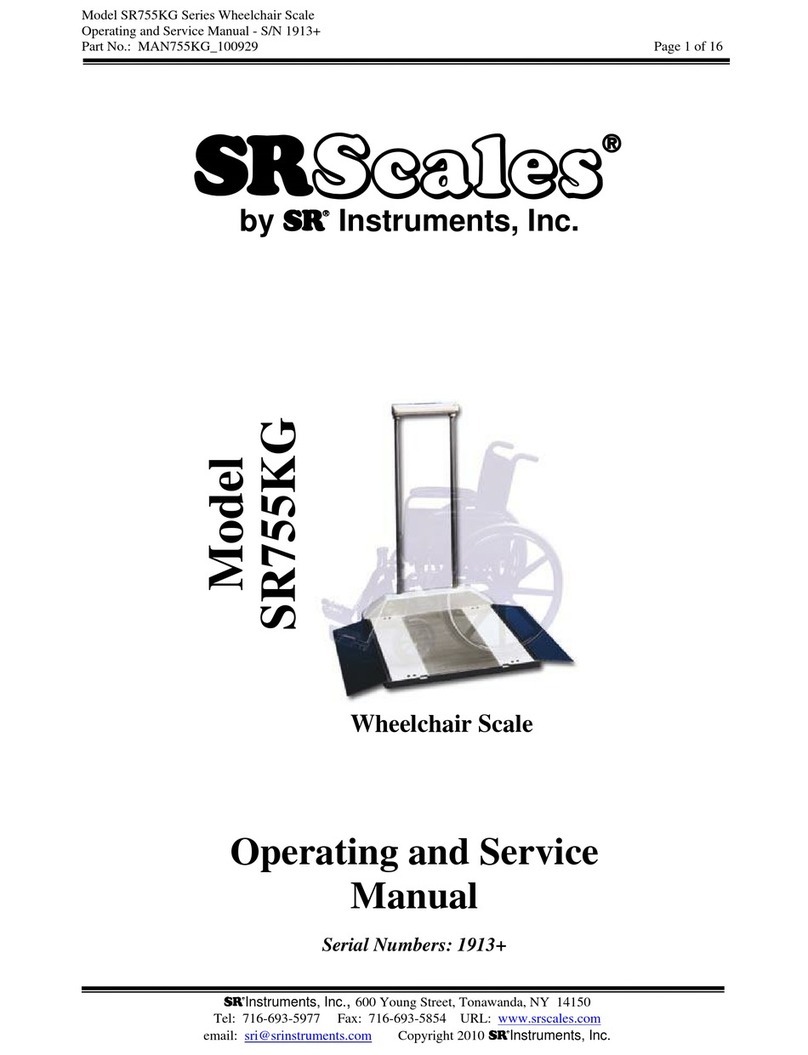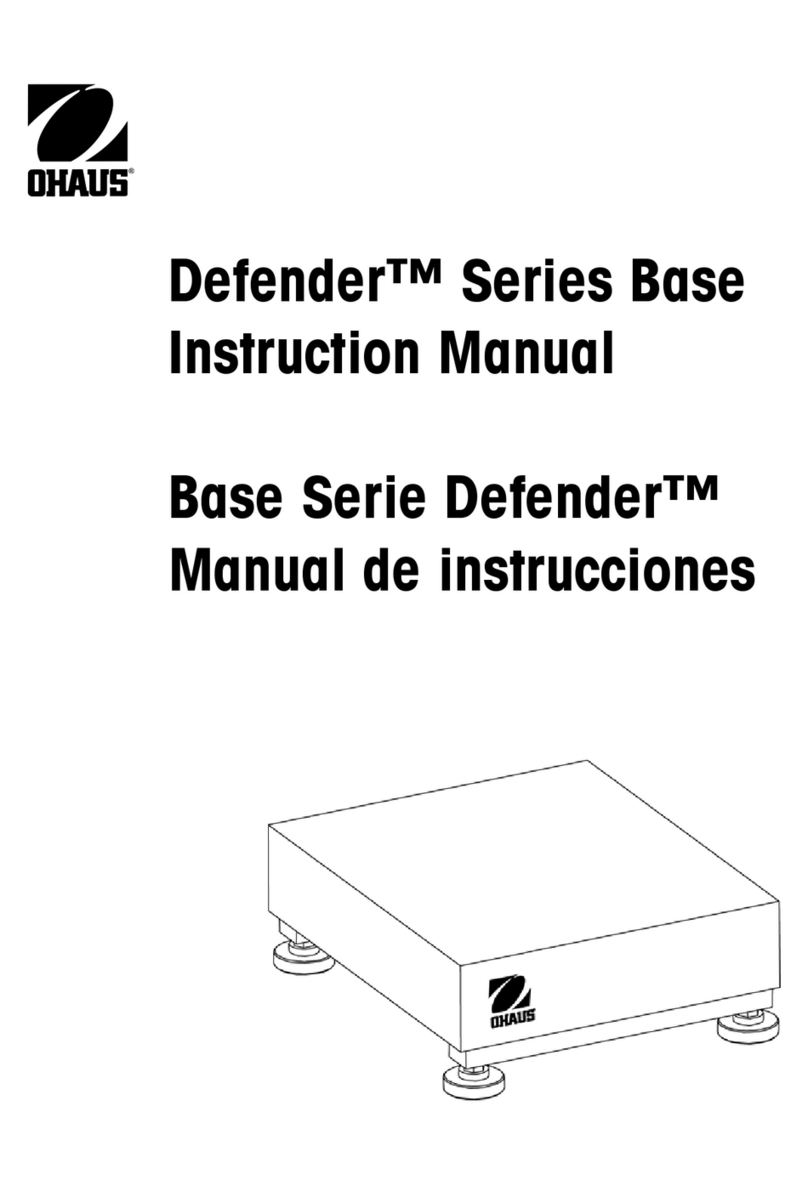Boeco BEB43 User manual

BEB Series
Serie BEB
Electronic Precision Scales/Balances
Balanzas electrónicas de precisión
Operating Instructions/Manual de instrucciones
98648-013-84

2
English page 3
In cases involving questions of
interpretation, the German-language
version shall prevail.
Español página 20
En caso de interpretación,
la versión en lengua alemana
será determinante.

3
Page
Warnings and Safety Precautions 4
Getting Started 5
Operation 8
Basic Weighing Function 8
Description of the Keys 8
Application Programs 9
Toggling between Weigh Units 9
Counting 10
Weighing in Percent 11
Display Lock Mode 12
Total/Formulation 13
Specific Gravity 14
Calibration/Span Adjustment 15
Advanced Features (Setup Menu) 16
Error Codes 17
Overview 18
Specifications 18
CMarking 19
3
Contents

4
Safety Information
●To prevent damage to the equip-
ment, please read these operating
instructions carefully before using
your balance/scale.
!Do not use this equipment in
hazardous areas.
!Make sure the voltage rating print-
ed on the power supply is identical
to your local line voltage.
!Use only commercially available
9 V batteries (not included).
If desired, you can use a
rechargeable battery.
– The balance/scale is energized
at all times unless you disconnect
the AC adapter and, if connected,
the battery.
– Protect the AC adapter from
contact with liquid
!Exposure to excessive electro-
magnetic interference can cause
the readout value to change.
Once the disturbance has ceased,
the instrument can be used again
in accordance with its intended
purpose.
Installation
– It is recommended to connect only
BOECO accessories and options,
as these are optimally designed
for use with your
balance/scale.
– Do not open the balance/scale
housing as this will void the
manufacturer’s warranty.
Symbols
The following symbols are used in
these instructions:
●indicates steps you must
perform
$indicates steps you must
perform only under certain
conditions
> describes what happens after you
have performed a certain step
– indicates an item in a list
!indicates a hazard
4
Warnings and Safety Precautions

5
Getting Started
Equipment Supplied
– Balance/scale
– Weighing pan
– AC adapter
Additional equipment with models
BEB53, BEB55:
– Calibration weight
Additional equipment with model
BEB43:
– Calibration weight
– Round glass draft ring
– Level indicator and adjustable feet
Installation
Choose a location that is not subject
to the following negative influences:
– Heat (heater or direct sunlight)
– Drafts from open windows and doors
– Extreme vibrations during weighing
– Excessive moisture
Setting Up the Balance/Scale
●Place the components on the
balance/scale in the following order:
– Reversible weighing pan
– Round glass draft ring on model
BEB43

6
Connecting the Balance/Scale
to AC Power
!Use only the AC adapter for
optimal performance and safety.
§Insert plug into the jack (located
on back of balance/scale)
§Plug the AC adapter into an
electrical outlet
!LISTED power supply 11 V–21 V
compliant with NEC Class 2 output.
Below-Balance/Under-ScaleWeighing
A port for a below-balance weighing
hanger is located on the bottom of the
balance/scale.
§Open the cover plate on the
bottom of the balance/scale.
§Attach the sample (e.g., using
a suspension wire) to the hanger.
$Install a shield for protection
against drafts if necessary.
Installing the Battery
(not for model BEB43)
$Batteries are not included with the
equipment supplied
!Use only commercially available
9 V batteries.
!If you use a rechargeable battery,
recharge it with an external battery
charger.
§Lay the balance/scale on its side
§Open the battery compartment:
remove the compartment cover
§Install the battery in the compart-
ment
$Make sure the polarity is correct.
§Close the battery compartment:
slide the cover into position until
it snaps into place
!Do not throw away used batteries
with normal household waste.
Rechargeable batteries contain
toxic materials and must be dis-
posed of in accordance with local
waste disposal regulations.

7
Leveling the Balance/Scale
(only for model BEB43)
§Always level the balance/scale again
any time after it has been moved to
a different location.
§Turn the front feet as shown in the
diagram until the air bubble is cen-
tered within the circle of the level
indicator.
§Lower all feet to touch the counter-
top so the balance/scale does not
rock.
> In most cases this will require
several adjustment steps.
RemovingWeights for
Calibration/Span Adjustment
(not for model BEB61)
§Grasp the tab to turn and pull out the
weight compartment.
§Always wear gloves or use tweezers
when handling weights.
$Follow instructions on page 15 for
calibration/span adjustment.
WarmupTime for Model BEB43:
To ensure accurate results, the scale
must warm up for 1 hour before opera-
tion. Only after this time will the scale
have reached the required operating
temperature.

8
Operation
BasicWeighing Function
Features
– Zeroing the balance/scale
You can zero the balance/scale within
the entire weighing range, up to the
maximum capacity.
Preparation
§Switch on the balance/scale:
press the (ON/OFF) key
§If necessary, zero the balance/scale:
press the (ZERO) key
$If necessary, change the configura-
tion settings: see the chapter entitled
“Configuration”
$If desired, reset the factory settings:
see the chapter entitled “Advanced
Features,” menu item 9.– 1
Additional functions:
$Switching off the balance/scale:
press the (ON/OFF) key
$Battery operation: automatic shut-off
after 2, 5 or 10 minutes; see chapter
on configuration. Example: 2 min-
utes. If the weight readout remains
unchanged and no keys are pressed
for at least two minutes, the battery
symbol “ “ starts flashing.
After another 2 seconds, the bal-
ance/scale shuts off automatically,
unless a key is pressed.
Description of the Keys
(ON/OFF) On/off key: switches the bal-
ance/scale on and off or
switches it to the standby
mode.
Battery operation: on; turns
backlight on; off
(ZERO) Zeros the balance/scale;
press and hold 2 seconds:
enters application menu
(CAL) Starts calibration/adjustment
(F) Starts an application pro-
gram; scrolling in applica-
tion menu, configuration
menu and calibration menu
(ENTER) Confirms the selected
setting; exits application,
configuration & calibration
menu if key is pressed
and held for at least
2 seconds.
(PRINT) Generates a printout or data
output
Example: Determine weight of sample
Step Key (or instruction) Display
1. Switch on the balance/scale (ON/OFF)
Self-test runs
Display: Software version r 31.01 g
2. Place container on the balance/scale
(in this example, 52 g) 52.0 g
3. Zero the balance/scale (ZERO) 0.0 g
4. Place sample in container on
balance/scale (in this example, 150.2 g). 150.2 g

9
Application Programs
Toggling betweenWeigh Units
With this application program you can toggle the display of a weight value back
and forth between two weigh units (see table below).
Example: Toggle weigh unit from pounds [lb] (application) to grams [g] (basic unit)
Step Key (or instruction) Display
1. Select application program (ZERO) ≥2 sec
2. Select Toggling between Weigh Units (F) repeatedly
3. Confirm unit of application* (ENTER)
4. Select weigh unit; in this example: (F) repeatedly
“5. Pounds” (see table below)
5. Confirm weigh unit (pounds) (ENTER)
6. Place sample on balance/scale
7. Toggle weigh unit (F)
Menu code Unit Conversion factor Display
1. user** Grams 1.00000000000 o
2.grams (factory setting) Grams 1.00000000000 g
4.carat Carats 5.00000000000 o
5.Pound Pounds 0.00220462260 lb
6.ounce Ounces 0.03527396200 oz
7.tryo Troy ounces 0.03215074700 ozt
8.tl.hon Hong Kong taels 0.02671725000 tlk
9.tl.sin Singapore taels 0.02645544638 tl
10.tl.ta Taiwanese taels 0.02666666000 tl
11.grai Grains 15.4323583500 GN
12.peny Pennyweights 0.64301493100 dwt
15.tl.ch Chinese taels 0.02645547175 tl
22.pdoz lb/oz 0.03527396200 lb:oz
23.ne t Newtons 0.00980665000 N
* Grams is chosen as 1st unit; to changes 1st unit, see Advanced Features section.
** User-defined conversion can be loaded in balance/scale with RS-232 or USB
program option. Contact BOECO for more information.

10
Counting
Purpose
With the Counting program you can determine the number of parts or pieces by
weight.
Example: Determine the number of uncounted parts; calculate the sample
reference quantity (in this example: 20)
Step Key (or instruction) Display
1. Select application program (ZERO) ≥2 sec
2. Select Counting (F) repeatedly
3. Confirm application (ENTER)
Symbol “ “ on the display:
application is active
4. Place empty container on the
balance/scale
5. Zero the balance/scale (ZERO)
6. Place sample reference quantity (20)
on the balance/scale
7. Select sample reference quantity:
in increments of 1 (1, 2, 3, ..., 99) or (F) repeatedly (briefly) or
in increments of 10 (10, 20, 30, ...,100) (F) ≥2 sec.
8. Confirm selected sample reference
quantity (ENTER)
9. Place uncounted parts on balance/scale
10. Toggle display between mean piece
weight, total weight, and quantity (F) repeatedly
11. Unload the balance/scale
12. Start new Count application
or exit application (ENTER) ≥2 sec
13. Reactivate Counting (if no other (F)
application program has been selected)
14. Repeat procedure starting from Step 5.

11
Weighing in Percent
Purpose
This application program allows you to obtain weight readouts in percent which are
in proportion to a reference weight.
Example: Determine an unknown percentage; store the weight on the
balance/scale as the reference percentage (100%)
Step Key (or instruction) Display
1. Select application program (ZERO) ≥2 sec
2. Select Weighing in Percent (F) repeatedly
3. Confirm application (ENTER)
Symbol “ “ on the display:
application is active
4. Place empty container on the
balance/scale
5. Zero the balance/scale (ZERO)
6. Place the reference weight
for 100% on the balance/scale
7. If desired, change the number
of decimal places displayed: 100.0%,
100.00% or 100% (factory setting) (F) repeatedly
8. Confirm selected no. of decimal places (ENTER)
9. Place unknown weight on the
balance/scale
10. Toggle display between weight
and percentage (F) repeatedly
11. Unload the balance/scale
12. Start new Weighing in Percent
application or exit application (ENTER) ≥2 sec
13. Reactivate Weighing in Percent
(if no other application program
has been selected) (F)
14. Repeat procedure starting from Step 5.

12
Purpose
The last stable value remains displayed for 5 seconds after removing the sample
from the pan.
Example: Determine weight of oversized sample
Step Key (or instruction) Display
1. Select application program (ZERO) ≥2 sec
2. Select Display Lock (“HLdon”) (F) repeatedly
3. Confirm application (ENTER)
Symbol “ ” on the display:
application is active
4. If necessary: zero the balance/scale (ZERO)
5. Place sample on balance/scale
6. Start application program (F)
Symbol “ ” flashes on the display:
when stability conditions are met
7. Unload the balance/scale:
the weight value remains displayed
for a further 5 seconds; or
8. Zero the balance/scale (ZERO)
9. End the Display Lock application (ENTER) ≥2 sec
10. Reactivate Display Lock (if no other (F)
application program has been selected)
11. Repeat procedure starting from Step 5.
Display Lock Mode

13
Total/Formulation
Purpose
With this application program you can add successive weight values.
The cumulative weight can infinitely exceed the capacity of the balance/scale.
Example: Obtaining the total/formulation
Step Key (or instruction) Display
1. Select application program (ZERO) ≥2 sec
2. Select Total (formulation) (F) repeatedly
3. Confirm application (ENTER)
Symbol “ “ on the display:
application is active
4. If necessary: zero the balance/scale (ZERO)
5. Place sample on balance/scale
(in this example, 380 g)
6. Store value in memory. (ENTER)
Total weight is displayed
steadily; ∑symbol flashes.
If interface is connected, sample
weight is outputted automatically
7. Remove sample or press ZERO
8. Place the next sample
on the balance/scale
(in this example, 575 g)
9. Store value in memory. Total weight is (ENTER)
displayed; along with the flashing ∑icon.
Note: ∑symbol remains on, indicating
stored value in memory until cleared
(if interface is connected, sample weight
is outputted automatically).
10. To view current individual weight for (F)
2 seconds (if a printer is connected,
a printout is generated)
11. Clear Total memory (F) ≥2 sec
(if a printer is connected, total is printed)
12. Exit Total/Formulation (ENTER) ≥2 sec
13. Reactivate Totalizing (if no other (F)
application program has been selected)
(if a printer is connected, total is printed).
14. Repeat procedure starting from Step 6.

14
Specific Gravity
Purpose
Use this application program to determine the specific gravity of a sample.
The calculation used is Result = Weight in air/(Weight in air – Weight in water).
The result is displayed with one decimal place.
Beaker and wire not included with balance/scale.
Example: Determine the specific gravity of a solid.
Step Key (or instruction) Display
1. Select application program (ZERO) ≥2 sec
2. Select Specific Gravity (F) repeatedly
3. Confirm application (ENTER)
Symbol “ “ on the display:
application is active
4. If necessary, zero the balance/scale (ZERO)
5. Start application program (F)
6. Confirm the display, “airval” (ENTER)
7. Determine weight of the sample in air:
place sample on the balance/scale
8. Store weight-in-air value (ENTER)
9. Remove sample from balance/scale
10. Determine weight of sample in liquid:
connect wire and set up beaker
11. Confirm the display “Water” (ENTER)
12. Place sample in liquid
13. Store the weight-in-liquid value
and view the result (ENTER)
14. Clear the display (ZERO)
15. Exit the Specific Gravity application (ENTER) ≥2 sec
16. Reactivate Specific Gravity (if no other (F)
application program has been selected)
17. Repeat procedure starting from Step 5.

15
Calibration/Span Adjustment
Features
Calibration/adjustment can be
performed only when:
– there is no load on the balance/scale,
– the scale is zeroed, and
– the internal signal is stable.
If these conditions are not met, an error
message is displayed.
The weight required for calibration/span
adjustment is displayed.
Standard calibration weights for selected
models: to remove, see instructions on
page 7.
Press (F) to select a different weight
value.
To cancel the procedure: press and
hold the (ENTER) key (≥2 sec.).
Example: Calibrate/adjust span of the balance/scale (here: model BEB61)
Step Key (or instruction) Display
1. Switch on the balance/scale (ON/OFF)
2. Zero the balance/scale (ZERO)
3. Start calibration (CAL)
The preset calibration weight
is displayed without the weigh unit
(in this example, 5000 g)
4. To select a different calibration
weight value (F) repeatedly
5. Start calibration/span adjustment (ENTER)
After the zero point is stored, the required
calibration weight flashes on the display.
6. Place the required calibration
weight on the balance/scale
The readout stops flashing if the weight
is applied within the defined time limit and
tolerance. If the weight value is accepted,
the display stops flashing and the stability
symbol appears on the display.
7. Remove the calibration weight
8. Calibration/span adjustment has
been completed
Calibration is recommended after initial installation and each time the
balance/scale is moved.

16
Advanced Features (Setup Menu)
Purpose: Serveral advanced balance operations can be changed through menu codes.
Select the desired codes from the list below. Then follow the steps to change the menu codes.
Step Key (or instruction) Display
1. Turn balance off. (ON/OFF)
2. Turn the balance back on. While all segments ZERO
are displayed, press ZERO key once.
3. Increase the number on display to desired value. MODE
4. Move to the 2nd number of the code. ENTER
5. Increase the second number on display MODE
to desired value.
6. Move to the 3rd number of the code (when you ENTER
move to the third number, the previously set menu
code will appear).
7. Increase the third number on display to desired value. MODE
8. Confirm new code Hold down the ENTER key until ”0“ appears after
the desired code.
9. Exit setup menu. Press ZERO for more than 2 seconds
Special Keyfinctions for Menu Code Operation
Key Press briefly Press and hold
(F) Increase a number by one with each press
(ENTER) Moves to the next of three numbers of a code; hold to confirm setting
(ZERO) Moves to the previous number of a codes; hold to exit set-up.
Parameter Settings (Overview) οFactory setting
Setup 1 Weighing 1.1. Adapt filter 1.1.1 Very stable conditions
menu 1.1.2 οStable conditions
1.1.3 Unstable conditions
1.1.4 Very unstable conditions
1.2. Application filter 1.2.1 οFinal readout
1.2.2 Filling
1.3. Stability range 1.3.1 1/4 digit
1.3.2 1/2 digit
1.3.3 1 digit
1.3.4 ο2 digits
1.3.5 4 digits
1.5. Calib./adjust./linearization: 1.5.1 οCalibration/span adjustment
Function of the (CAL) key 1.5.2 Linearization: for service
personnel only
1.5.3 Key blocked
1.6. Auto zero 1.6.1 οOn
1.6.2 Off
1.7. 1st weigh unit, or 2nd unit 1.7.1 User-defined unit: see
in Toggle Weigh Units app. to 1.7.23 “Toggling between Weigh Units”
5. and 6. Interface settings; see manual for interface accessory
8. Additional 8.1. Block key functions 8.1.1 All keys blocked except
functions (with battery use only) for (ON/OFF) and (ZERO)
8.1.2 οAll keys unblocked
8.2. Automatic shut-off 8.2.1 οAfter 2 minutes
(with battery use only) 8.2.2 After 5 minutes
8.2.3 After 10 minutes
9. Reset menu 9.1. Factory settings 9.1.1 Restore
9.1.2 οDo not restore

17
Error Codes
Most error codes are shown on the main display for approx. 2 seconds.
The program then returns automatically to the previous mode.
Display/Problem Cause Solution
No segments appear No power available Check the power supply
on the display
The AC adapter is not plugged in Plug in the AC adapter
Battery is drained Replace battery; recharge
battery using external charger
oL The load exceeds the Unload the balance/scale
balance/scale capacity
UL Weighing pan not in place Place the weighing pan
on the balance/scale
Something is touching Move the object that is
the weighing pan touching the weighing pan
disErr Display overflow: Reduce load on the balance/scale
Value cannot be shown on the display
calErr Calibration parameter not met; e.g.: Calibrate only when zero
is displayed
– Balance/scale not zeroed Press (ZERO) to tare the
balance/scale
– Balance/scale is loaded Unload the balance/scale
appErr Weight is too light or there is Increase the weight
no sample on the balance/scale on the balance/scale
with application in use
PrtErr Data interface for Contact the BOECO
printing is blocked customer service center
Bal.Err Balance/scale loaded or defective Unload balance/scale before
when power was turned on switching on or contact
BOECO customer service*
Sep.Err Balance/scale defective Contact BOECO customer service
Max. weighing capacity The balance/scale was Place the weighing pan
is less than indicated switched on without on the balance/scale and
under “Specifications” the weighing pan in place press (ON/OFF)
The weight readout The balance/scale was not Calibrate/adjust the balance/scale
is obviously wrong calibrated/adjusted before weighing
Balance/scale not zeroed Zero the balance/scale
If any other errors occur, contact your local BOECO customer service center
* This fault will appear on the display when the unit is powered on. This occurs when the electronics are no longer within the factory set parameters.
The most common cause is from objects being dropped onto the weighing pan or from the balance itself being dropped. The balance must be returned for service.

18
Overview
Specifications
Model BEB43 BEB53 BEB55
Weighing capacity g 120 610 210
Readability g 0.001 0.01 0.01
Tare range (subtractive) g 120 610 210
Linearity ≤±g 0.003 0.03 0.03
Operating temperature range 10°C to 30°C (273°K to 303°K; 50°F to 86°F)
Response time (average) s 2.5 2 2
Adaptation to ambient conditions By selection of 1 of 4 optimized filter levels; display update:
s 0.1–0.8 sec. (depends on filter level selected)
Calibration weight g 100* 200* 200*
Net weight, approx. kg/lb 1.2/2.6 1.35/2.9 1.2/2.6
Pan size mm/in 97/3.8 d142+130/5.6+5.1 97/3.8 d
Power source/voltage/frequency AC adapter, 230 V or 115 V, +15% to – 20%, 48–60 Hz
Power consumption (average) W 1 0.75 0.75
Hours of operation w/ 9V battery:
– Alkaline (approx.) h – 11 14
– Rechargeable, fully ch. (NiMH), avg. h – 2.5 4
Model BEB61
Weighing capacity g 5000
Readability g 0.1
Tare range (subtractive) g 5000
Linearity ≤±g 0.2
Operating temperature range 10°C to 30°C (273°K to 303°K; 50°F to 86°F)
Response time (average) s 2
Adaptation to ambient conditions By selection of 1 of 4 optimized filter levels; display update:
s 0.1–0.8 sec. (depends on filter level selected)
Calibration weight kg 5*
Net weight, approx. kg/lb 1.1/2.4
Pan size mm/in 142+130/5.6+5.1
Power source/voltage/frequency AC adapter, 230 V or 115 V, +15% to – 20%, 48–60 Hz
Power consumption (average) W 1
Hours of operation w/ 9V battery:
– Alkaline (approx.) h 11
– Rechargeable, fully ch. (NiMH), avg. h 2.5
* included with the balance

19
CMarking
The balance/scale complies with the
following EC Directives and European
Standards:
Council Directive 89/336/EEC
“Electromagnetic compatibility
(EMC)”
Applicable European Standards:
Limitation of emissions:
In accordance with product standard
EN 61326-1 Class B (residential area)
Defined immunity to interference:
in accordance with product standard
EN 61326-1
(minimum test requirements,
non-continuous operation)
Important Note:
The operator shall be responsible
for any modifications to BOECO equip-
ment and must check and, if necessary,
correct these modifications.
On request, BOECO will provide
information on the minimum operating
specifications (in accordance with the
Standards listed above for defined
immunity to interference).
73/23/EEC“Electrical equipment
designed for use within certain
voltage limits”
Applicable European Standards:
EN 60950
Safety of information technology
equipment including electrical business
equipment
EN 61010
Safety requirements for electrical
equipment for measurement, control
and laboratory use
Part 1: General requirements
If you use electrical equipment in
installations and under ambient condi-
tions requiring higher safety standards,
you must comply with the provisions as
specified in the applicable regulations
for installation in your country.

20
Contenido
Página
Contenido 20
Advertencias de seguridad 21
Puesta en marcha
Funcionamiento 25
Función básica: Pesar 25
Descripción de teclas 25
Programas de aplicación 26
Conmutación de unidades 26
Conteo 27
Pesada en porcentaje 28
Lectura estática 29
Totalización 30
Densidad/Peso específico 31
Calibración 32
Ajustes previos (menú Setup) 33
Mensajes de error 34
Sinopsis 35
Especificaciones técnicas 35
Marca C36
This manual suits for next models
3
Table of contents
Languages:
Other Boeco Scale manuals
Popular Scale manuals by other brands
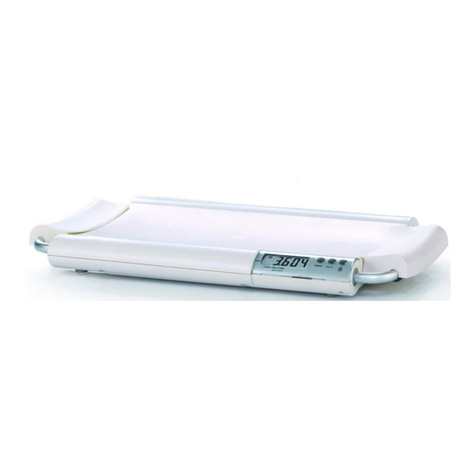
Charder
Charder MS 2400 user manual
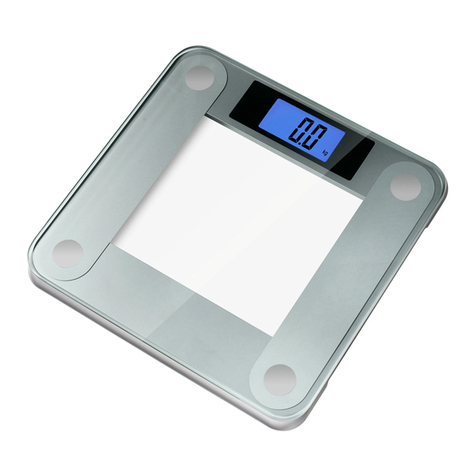
Ozeri
Ozeri Precision II user manual

Integrated Visual Data Technology Inc.
Integrated Visual Data Technology Inc. SkidWeigh ED2-2X Series Installation & Calibration Manual
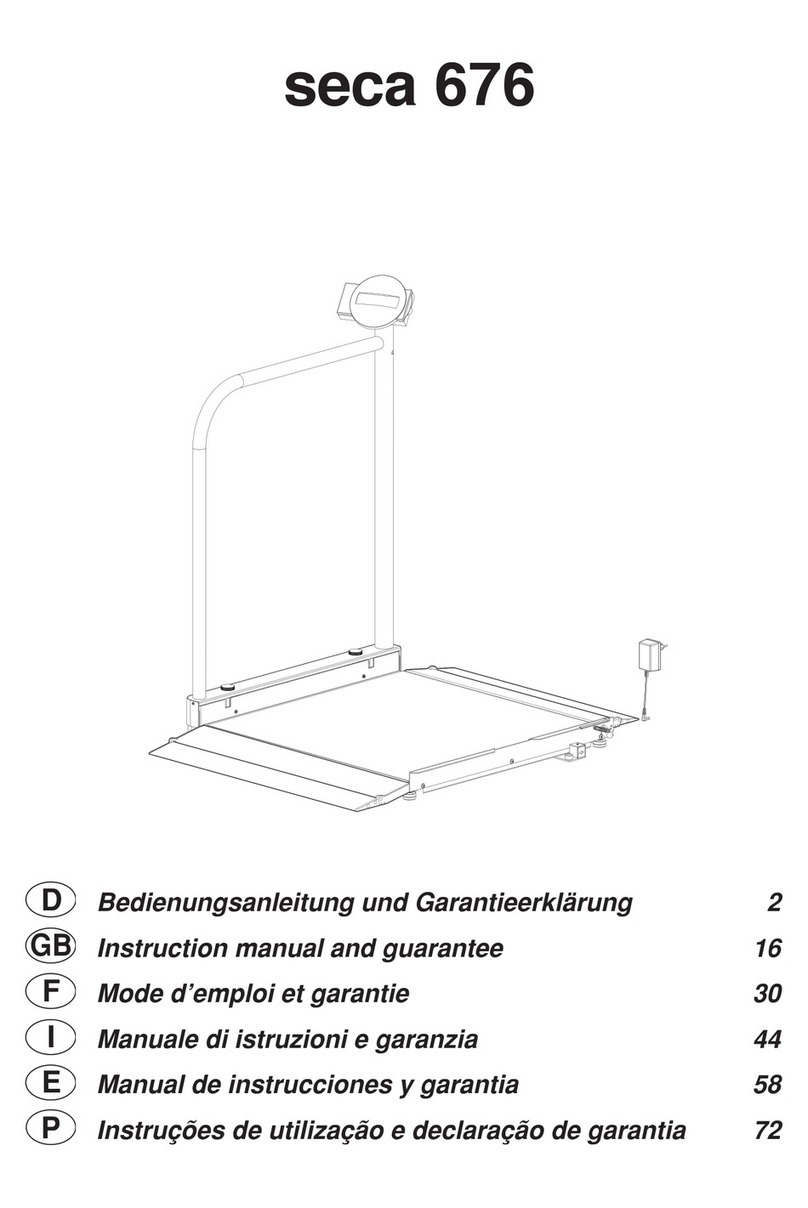
Seca
Seca 676 instruction manual

KERN
KERN EFC 30K-3 user manual
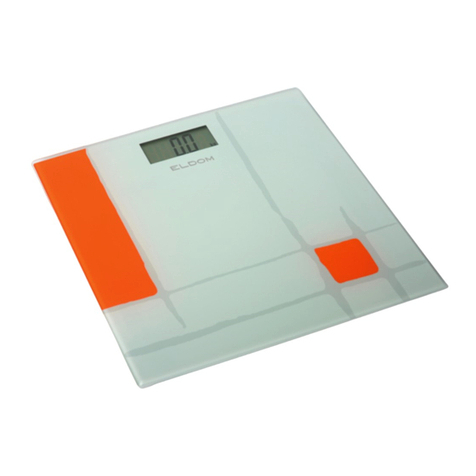
Eldom
Eldom EMMA GWO230 instruction manual
